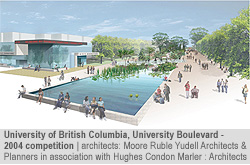The competition brief is a document that includes all instructions to competitors for participating in a competition.
Preparation of a Competition Brief
Endorsed competition: The professional advisor prepares the competition brief and may request the help of others to assist with various sections.
Non-endorsed competition: The RAIC strongly recommends that the sponsor engage a professional advisor, an architect with experience in managing competitions, to prepare the competition brief and manage the competition process.
Outline of a Sample Competition Brief
Below you will find the headings and brief descriptions of content for a sample competition brief. This information is for an endorsed competition, but it also forms the basis for a non-endorsed competition. In either case, headings and content will vary according to the specific needs of the competition.
1. Table of Contents
A listing of contents.
2. Introduction
An overview of the type of competition, purpose, scope, location, and other pertinent facts.
3. Definitions
Definitions of terms used in the specific competition.
4. Procedural Rules and Conditions
Procedural rules and conditions as they apply to the specific competition and have been agreed to by the appropriate provincial or territorial association of architects or the RAIC.
5. Objectives of the Competition
Clearly defined objectives as they apply to the specific competition. For example, is the primary objective to select a concept design and architect or is it to select the architect?
6. Sponsor
Names the sponsor as well as that portion of the sponsor’s organization responsible for managing the competition and the key personnel.
7. Eligibility
Identifies who can enter the competition. Eligibility depends on whether the competition will be open, limited, or invited.
8. Professional Advisor
Names the professional advisor and outlines the role and responsibilities of the professional advisor.
9. Jury
Names members of the jury and outlines their role. In an endorsed competition, the jury makes the final decision.
10. Awards and Payment to Competitors
Awards and payment as they apply to the specific competition.
11. Submission Requirements
 Submissions vary according to the type, cost, and complexity of the project. In general, competitors must supply sufficient information to demonstrate how they have responded to the sponsor’s needs. Submission requirements typically include site plans, floor plans, elevations, sections, perspectives or digital “pass-throughs,” and information on key design features such as sustainability. Often confirmation that the sponsor’s budget and schedule can be met is a requirement.
Submissions vary according to the type, cost, and complexity of the project. In general, competitors must supply sufficient information to demonstrate how they have responded to the sponsor’s needs. Submission requirements typically include site plans, floor plans, elevations, sections, perspectives or digital “pass-throughs,” and information on key design features such as sustainability. Often confirmation that the sponsor’s budget and schedule can be met is a requirement.
Other factors regarding submissions are:
-
Scope of the competition budget: The more money a sponsor has, the more design details the sponsor can require from competitors. With a more limited budget, the sponsor may have to cut back on submission requirements.
-
Digital technology: Submission content and media can vary according to factors such as how the judging is to proceed and whether there will be exhibitions or publications of the submissions post-competition.
-
If the competition is to be held in two stages: Where the sponsor wishes to narrow the number of competing architects from the original numbers.
12. Functional Program
All information on the project is identified relative to the level of detail in the submission requirements. Includes criteria and data for a building project, including design objectives, site requirements and constraints, spatial requirements and relationships, building systems and equipment, and future expandability. It is important to maintain a correct balance between too much and too little information. Providing the appropriate functional program is an important responsibility for the professional advisor.
13. Competition Budget
The budget as it applies to the specific competition, including a description of how and when it was prepared and how it relates to the proposed construction timeframe.
14. Competition Schedule
The schedule as it applies to the specific competition. It typically includes
the date for registration, final dates for questions and answers, dates for jury selection, and when the sponsor awards the commission (the contract for the design of the building to the winning architect) as well as time allowed for design, preparation of construction documents, and tender and construction. This information is important to the competitors for allocation of their internal resources.
15. Post-Competition Activities
Activities as they apply to a specific competition, including preparation and release of the jury report, media releases, the award of commission, an exhibition of submissions, a publication of submissions, and return of submissions.

 Submissions vary according to the type, cost, and complexity of the project. In general, competitors must supply sufficient information to demonstrate how they have responded to the sponsor’s needs. Submission requirements typically include site plans, floor plans, elevations, sections, perspectives or digital “pass-throughs,” and information on key design features such as sustainability. Often confirmation that the sponsor’s budget and schedule can be met is a requirement.
Submissions vary according to the type, cost, and complexity of the project. In general, competitors must supply sufficient information to demonstrate how they have responded to the sponsor’s needs. Submission requirements typically include site plans, floor plans, elevations, sections, perspectives or digital “pass-throughs,” and information on key design features such as sustainability. Often confirmation that the sponsor’s budget and schedule can be met is a requirement.